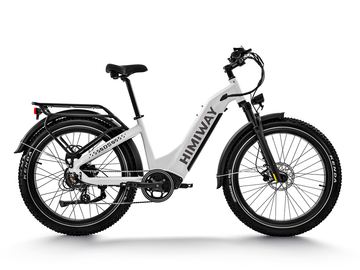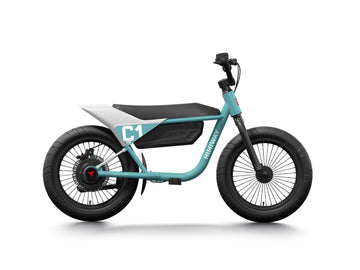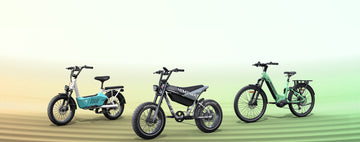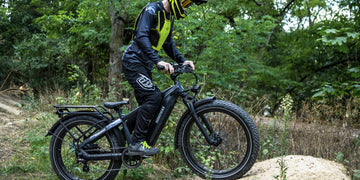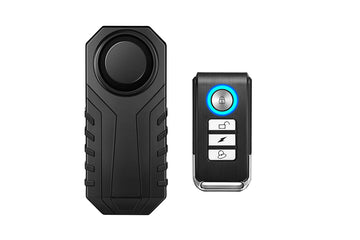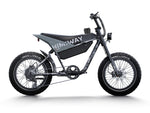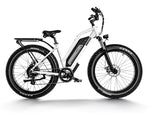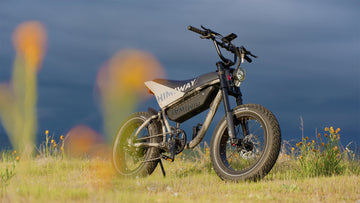But the reality is that we cannot control the weather, and sometimes riding an electric bike in the rain is a necessity. Fortunately, there are mitigating steps that you can take so that bike riding in the rain is not as dangerous or intimidating as it otherwise would be. To help get you where you need to go more safely, here are 10 easy tips for riding an electric bike in the rain.
Weatherproof Yourself and Your Stuff
If you find yourself riding a bike on a rainy day, the first thing you should do is ensure you are taking basic weatherproofing steps to protect yourself and your stuff. This includes wearing a safety helmet, waterproof gloves, a raincoat, and waterproof shoes. Some bike riders underestimate the importance of good traction, but maintaining a solid grip on the handlebars and footing on the pedals are critical to riding a bike safely in the rain. When transporting valuables, it is also worth carrying a waterproof backpack, such as a Himiway waterproof backpack, to keep them dry.
Premium All-terrain Electric Fat Bike D5 Pro
-
960
Wh
Samsung/LG Battery
-
80
Miles
Per Charge (maximum)
-
500
W
Mid-Drive Motor
-
20+
Mph
Top Speed
Use Electric Bike Lights and Reflectors
One of the most detrimental impacts of rain, particularly heavy rain, is its ability to restrict visibility. Because visibility is reduced on rainy days, it is important to make sure others around you—particularly drivers—can easily see you. The best way to do this is by adding lights and reflectors to your electric bike, including front lights and rear lights. For more information about adding lights to your electric bike, check out our buying guide for electric bike lights.
Brake Early
The first two tips for riding an electric bike in the rain more safely are about prepping for the ride. Now it is time to discuss tips for while you are riding. The first is to remember to break early. Braking early allows you to slow down gradually, and therefore maintain traction throughout the process. Late braking on wet surfaces can lead to skids and potentially losing control of the bike.
Slow Down
Riding electric bikes in the rain follows many of the same safety protocols as driving in the rain. One primary rule is that when riding on wet roads, you should ride slower than you normally would. This follows the same reasoning as braking early. If you are riding slower, you have better control over the electric bike and can react quicker.
Lower Tire Pressure
Something many bikers do not think about, lowering the tire pressure on your electric bike, can actually increase traction when riding in the rain. When tires are not inflated fully, more surface area of the tire can grip the road, which increases stability in wet weather. Just remember to reflate them once the roads dry up.
Use Electric Bike Fenders
Fenders serve an important function, especially in the rain—and they are not only good for keeping your bike clean. While most electric bikes are waterproof, adding mudguards can help to reduce the possibility of small debris entering the bike. This will help better protect the bike, a particularly essential task when bike riding in the rain.
Cover Your Electric Bike’s LCD Screen
All vehicles are dependent upon their LCD screens to function properly. However, most vehicles do not expose their LCD screens to the elements. Because electric bikes’ LCD screens are vulnerable to heavy rain, it is imperative that you take measures to protect them. One effective method is to use some transparent plastic to cover the screen. This will keep any water from entering the LCD screen, which not only would make it more difficult and therefore dangerous to ride in the rain, but could also lead to expensive repairs.
Use Rust Protection Spray
Taking preventative measures to extend the life of your electric bike will ultimately make it a better performing machine, and that includes the important function of riding smoothly and safely in the rain. Most bikes will have some original waterproofing, but it is worth the extra step of adding more waterproofing yourself. This includes coating the surface with anti-rust spray to minimize the possibility of rust. As a bonus to prolonging the electric bike’s life and helping it perform better in the rain, keeping it free of rust will also allow it to better hold its value.
Carry an Emergency Kit
When you are on the road, it is always best to be prepared for any situation, but particularly so when you are riding in the rain. As rain can cause unpredictable scenarios, ensure that you have an emergency kit with you at all times. This kit should include things like bandages, a hand-operated flashlight, portable maintenance tools, batteries, and other helpful tools.
Clean Your Electric Bike After You Ride
Another important tip for riding your electric bike in the rain is to ensure you take the time to clean it afterward. This includes washing it, but also making sure that it is properly dried to avoid any long-term damage that rain can have on a bike, such as rust.
While it is perhaps not practical to implement all 10 of these tips for riding an electric bike in the rain more safely, they will each individually help increase your stability and make bike riding in the rain easier, safer, and more enjoyable.

